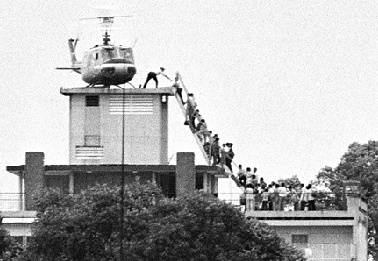"I remember the tail gunner on the helicopter -- they look like giant bugs -- and it was the prettiest thing I every saw -- when I saw that guy sitting at the back of the helicopter, I knew we'd made it then." (Doug Potratrz, U.S. Marine in Vietnam)

"The temperature in Saigon is 112 and rising" said the broadcaster on the radio in Saigon, Vietnam on April 29, 1975. The weather report was followed immediately by the playing of "I'm Dreaming of a White Christmas". Was it Christmas in April? No, this was the cue that Operation Frequent Wind had commenced, the evacuation of American and South Vietnamese civilians from South Vietnam in the closing hours of the war. The iconic image, captured by Hubert Van Es, shows the desperate souls climbing up a ladder onto the roof of the U.S. Embassy to board a helicopter to freedom.
When "White Christmas" stopped playing on the Saigon radio, busses started arriving at key points in the city ready to load up with refugees. The goal was to take as many civilians as possible to two escape locations, the American Embassy and the Defence Attache Office. Helicopters, their propellers whirring, sat ready to transport the refugees from these locations to the South China Sea where they were picked up by aircraft carriers.
The plan went so well that American military personnel were able to load each bus three times rather than once. The overflow of refugees was evident when they reached the South China Sea: pilots on the U.S.S. Okinawa and other ships were given the order to dump already emptied helicopters overboard or even ditch them in the sea since there was no more room for them on the aircraft carriers.
Operation Frequent Wind participants were successful in evacuating 7000 refugees in a two day period. In all, 675,000 refugees were evacuated from South Vietnam in the dying weeks of the war, double the number evacuated at Dunkirk. Sadly, 400 third-country civilians were left behind at the embassy and/or the Defence Attache Office. The musical Miss Saigon, inspired by the iconic rooftop photo, is based on a couple who is separated during the final days of the war.
Saigon was renamed Ho Chi Minh City. The ladder used to evacuate hundreds from the rooftop of the U.S. Embassy in Saigon sits now in the Gerald Ford Museum.
Note: For more information, read Last Men Out: The True Story of America's Heroic Final Hours in Vietnam (Bob Drury & Tom Clavin).

No comments:
Post a Comment